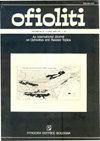Structural setting and metamorphic evolution of a contact aureole: the example of the Mt. Capanne pluton (Elba Island, Tuscany, Italy)
IF 1.3
4区 地球科学
Q2 GEOLOGY
引用次数: 7
Abstract
This paper shows an updated geological, petrographical-chemical and structural picture of the contact aureole of the 6.9 Ma Mt. Capanne monzogranitic pluton in western Elba Island (Tuscan Archipelago), that is one of the most known Tertiary intrusive bodies in Italy. Most of the foliated metamorphic rocks derived from a Mesozoic Ligurian-type ophiolitic succession (Punta Polveraia-Fetovaia Unit) and are in the horneblende to pyroxene hornfels facies with estimated Tpeak > 610°C (locally > 650°C). Local variations of the metamorphic zonation of the at least 150-200 m thick aureole are due to the different lithological, physical and structural (e.g., bedding, fracturing) nature of the original rocks, but also to hydrofracturing phenomena which occurred during the syn-metamorphic upflow of the metasomatic hot fluids. The history of the emplacement and uplift of the Mt. Capanne pluton was defined through the metamorphic-structural evolution of its contact metamorphic aureole. The growth of the thermometamorphic minerals took place in several stages being both syn-kinematic with respect to the main ductile D 2 folding event (connected to the plutonic intrusion) and static post-kinematic one. Ductile shear zones, characterized also by mylonites, were also active during recrystallization in a general shear-type regime (average value of W m = 0.7) related to the vertical uplift of the pluton (pure shear) and lateral ductile flow of the covers (simple shear). The exhumation of the cooled pluton continued producing tangential cascade-type folding event (D 3 ), detachment faults, and later high-angle faulting in the host rocks. The role of Western Elba in the geological frame of the whole island since Late Miocene times is also outlined in the paper.接触光环的构造背景与变质演化——以意大利托斯卡纳厄尔巴岛卡潘尼火山为例
本文对意大利最著名的第三系侵入岩体之一、位于托斯卡纳群岛厄尔巴岛西部的Capanne山6.9 Ma二长花岗岩岩体的接触光圈进行了最新的地质、岩石化学和构造成像。大部分片理变质岩来自于中生代利古里亚型蛇绿岩演替(Punta Polveraia-Fetovaia单元),属于角闪石-辉石角砾岩相,峰值温度为> ~ 610℃(局部温度为> ~ 650℃)。至少150-200 m厚的光晕的局部变质带变化是由于原始岩石的岩性、物理和构造(如层理、压裂)性质不同,但也与变质热流体在同变质上涌过程中发生的水力压裂现象有关。通过其接触变质光环的变质-构造演化,确定了卡帕纳山岩体的侵位和隆升历史。热变质矿物的生长经历了几个阶段,既与主要的韧性d2褶皱事件(与深部侵入有关)有关,又与静态的后运动事件有关。以糜棱岩为特征的韧性剪切带在重结晶过程中也很活跃,与岩体的垂直隆升(纯剪切)和盖层的侧向韧性流动(单纯剪切)有关,在一般剪切模式下(平均W m = 0.7)也很活跃。冷却岩体的掘出继续产生切向级联型褶皱事件(d3)、滑脱断裂以及后来的主岩高角度断裂。本文还概述了晚中新世以来西厄尔巴岛在全岛地质格局中的作用。
本文章由计算机程序翻译,如有差异,请以英文原文为准。
求助全文
约1分钟内获得全文
求助全文
来源期刊

Ofioliti
地学-地质学
CiteScore
2.40
自引率
7.70%
发文量
1
期刊介绍:
Since 1976, Ofioliti provides an international forum for original contributions and reviews in the field of the geodynamics, petrology, geochemistry, biostratigraphy, stratigraphy, tectonics and paleogeography applied to ophiolitic terrains and modern oceanic lithosphere, including their sedimentary cover. Studies of topics such as geodynamics of the mantle, the evolution of orogens including ophiolites and paleoceanography are also welcome
 求助内容:
求助内容: 应助结果提醒方式:
应助结果提醒方式:


